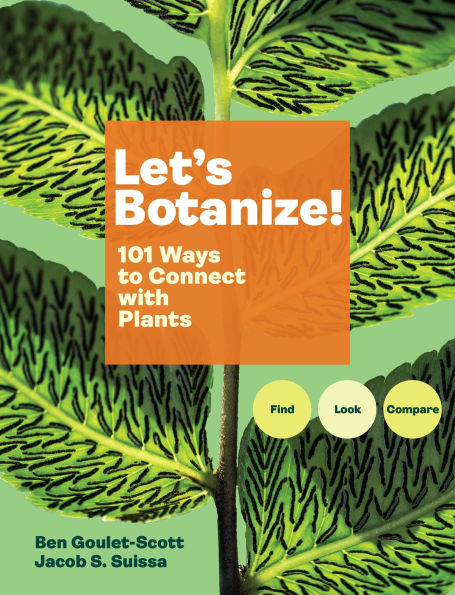Botanizing is the new birding! This fascinating book of 101 botany prompts is about the joy of getting to know plants in much the same way we get to know birds, through observation and attention.
Let's Botanize! is a guide to learning about and understanding the world of plants, a hobby that can ease stress, bring joy, and deepen your connection with the incredible diversity of life all around you. With easy entry points and lush photography, the 101 prompts inspire readers to engage with plant life meaningfully each day by observing the parts, patterns, and processes that make plants so amazing. Examine a bud at the tip of a branch—does it have hairs or scales? What is the most brightly colored plant part you can find that is not a flower or a fruit? Listen to the plants—what sounds do you hear them making? Follow the prompts on dedicated walks in the woods, on your sidewalk, on your commute to work, or even in your kitchen! Revisit prompts at different times of year, in different countries, climates, and ecosystems. As you learn more, you may even find that revisiting the same prompt and the same tree can provide a completely different perspective as you become more familiar with the wonderful world of plants.
This publication conforms to the EPUB Accessibility specification at WCAG 2.0 Level AA.
1147516459
Let's Botanize! is a guide to learning about and understanding the world of plants, a hobby that can ease stress, bring joy, and deepen your connection with the incredible diversity of life all around you. With easy entry points and lush photography, the 101 prompts inspire readers to engage with plant life meaningfully each day by observing the parts, patterns, and processes that make plants so amazing. Examine a bud at the tip of a branch—does it have hairs or scales? What is the most brightly colored plant part you can find that is not a flower or a fruit? Listen to the plants—what sounds do you hear them making? Follow the prompts on dedicated walks in the woods, on your sidewalk, on your commute to work, or even in your kitchen! Revisit prompts at different times of year, in different countries, climates, and ecosystems. As you learn more, you may even find that revisiting the same prompt and the same tree can provide a completely different perspective as you become more familiar with the wonderful world of plants.
This publication conforms to the EPUB Accessibility specification at WCAG 2.0 Level AA.
Let's Botanize: 101 Ways to Connect with Plants
Botanizing is the new birding! This fascinating book of 101 botany prompts is about the joy of getting to know plants in much the same way we get to know birds, through observation and attention.
Let's Botanize! is a guide to learning about and understanding the world of plants, a hobby that can ease stress, bring joy, and deepen your connection with the incredible diversity of life all around you. With easy entry points and lush photography, the 101 prompts inspire readers to engage with plant life meaningfully each day by observing the parts, patterns, and processes that make plants so amazing. Examine a bud at the tip of a branch—does it have hairs or scales? What is the most brightly colored plant part you can find that is not a flower or a fruit? Listen to the plants—what sounds do you hear them making? Follow the prompts on dedicated walks in the woods, on your sidewalk, on your commute to work, or even in your kitchen! Revisit prompts at different times of year, in different countries, climates, and ecosystems. As you learn more, you may even find that revisiting the same prompt and the same tree can provide a completely different perspective as you become more familiar with the wonderful world of plants.
This publication conforms to the EPUB Accessibility specification at WCAG 2.0 Level AA.
Let's Botanize! is a guide to learning about and understanding the world of plants, a hobby that can ease stress, bring joy, and deepen your connection with the incredible diversity of life all around you. With easy entry points and lush photography, the 101 prompts inspire readers to engage with plant life meaningfully each day by observing the parts, patterns, and processes that make plants so amazing. Examine a bud at the tip of a branch—does it have hairs or scales? What is the most brightly colored plant part you can find that is not a flower or a fruit? Listen to the plants—what sounds do you hear them making? Follow the prompts on dedicated walks in the woods, on your sidewalk, on your commute to work, or even in your kitchen! Revisit prompts at different times of year, in different countries, climates, and ecosystems. As you learn more, you may even find that revisiting the same prompt and the same tree can provide a completely different perspective as you become more familiar with the wonderful world of plants.
This publication conforms to the EPUB Accessibility specification at WCAG 2.0 Level AA.
14.99
Pre Order
5
1

Let's Botanize: 101 Ways to Connect with Plants

Let's Botanize: 101 Ways to Connect with Plants
Related collections and offers
14.99
Pre Order

Product Details
| ISBN-13: | 9781635869057 |
|---|---|
| Publisher: | Storey Publishing, LLC |
| Publication date: | 02/24/2026 |
| Sold by: | Hachette Digital, Inc. |
| Format: | eBook |
About the Author
From the B&N Reads Blog
